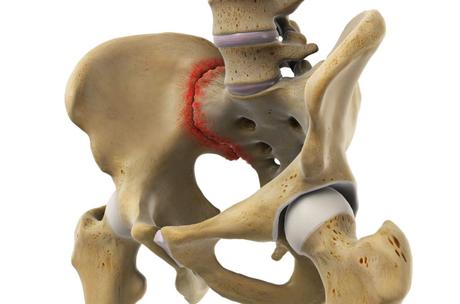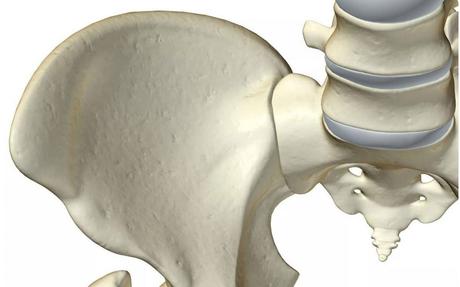Today we’re going to discuss a condition called SI joint pain. We’re going to discuss the causes of sacroiliac joint pain and the signs and symptoms of this condition. We’ll also discuss the traditional healthcare management of sacroiliac joint pain. So let’s get started.
A prevalent but frequently overlooked cause of pain in the low back is leaning forward without adequately supporting the anterior pelvis. This allows the innominate to rotate slightly downwards on the sacrum with fixation and an apparent increase in the length of the legs, irritating the sciatic nerve. This commonly occurs bilaterally but may appear on just one side. Flexion of the innominate(s) on the sacrum restores function to the sacroiliac joint, causes an apparent shortening of the legs and gives excellent relief of pain in the low back and sciatic pain.

What Even Is SI Joint Dysfunction?
Let’s discuss what SI joint is first. The SI joint is a connection between your sacrum and your ilium. Your sacrum is your tailbone, and the ilium is where you can put your hands on your hips. What happens is this connection between those two bones can be injured through overuse through running, lifting, walking, and/or sitting for long periods.
Sacroiliac joint (SI) dysfunction is a condition that results from the flawed movement of either one or both of two small, firm joints at the base of the spine. Typically, the sacroiliac joints have a very small range of motion, providing stability when, for example, a person is walking. They also absorb impact and serve the critical role of transferring the weight of the upper body to the lower body.
Hypermobility of the SI joint describes too much movement, which can lead to instability and pain in the lower back and hip that may radiate, or spread. An irritated SI joint can lead to inflammation in the joint, a condition known as sacroiliitis.
Symptoms of SI Joint Dysfunction
So let’s discuss the signs and symptoms of sacroiliac joint (SI joint) pain. Now, sacroiliac joint pain is an abnormal condition. One of the big signs people tell us is that if they sit for long periods, they’ll get pain in their back. So what do you do? They get up and go for a walk, and it starts to feel better for a little while, but then the pain returns. So then, what do you do? You sit back down, and it feels better for a little bit, and then it returns. Another sign or symptom is if you find yourself sleeping on one side. If you lay on the other side, your back hurts. That may be a sign of SI joint pain. The SI joint is at the base of the spine and forms the back part of the pelvis, so it assumes a lot of weight and stress from the upper body. It acts as a non-mobile shock absorber which works well when it’s functional, but when it breaks down, it can cause significant amounts of local pain, so people with SI joint pain will often present with pain when standing or walking for prolonged periods. They have difficulty sitting on the affected side, and rolling over in bed will cause pain and often wake them up from their sleep and have problems going up and down stairs because of the uneven slope; they have to negotiate. Interestingly, SI joint pain is much more common than previously believed. Studies have shown that between 15 and 30 percent of people
Those diagnosed with back problems suffer from SI joint pain, and when you factor in people who’ve previously undergone lumbar fusion surgery, the number is even higher, approximately 40%.

How Does Traditional Healthcare Usually Manage sacroiliac joint Dysfunction?
Now let’s discuss how traditional health care usually manages SI joint pain. They sometimes may suggest rest or decrease your activity. Heat or ice to the common to help with any inflammation. Pain medication to help, of course, help with your pain. Sometimes joint injections help get the rash out of the joint, and then in the worst case scenarios, possibly surgery to help fuse the joint.
How Does It Feel?
People with SIJ dysfunction may experience the following:
- Pain that may be sharp, stabbing or dull, localized to 1 side of the pelvis/low back, groin, or tailbone.
- Pain that may radiate down to the knee.
- Pain with movements, such as standing up from a sitting position, turning in bed, or bending/twisting.
- Muscle tightness and tenderness in the hip/buttock region.
- Pain with walking, standing, and prolonged sitting.
- Pain that is worse when standing and walking and eases when sitting or lying down.
What Will We Do With a Patient With sacroiliac joint Dysfunction Symptoms?

Let’s discuss how we are a bit different.
Typically if we see someone suspected of Socratic joint dysfunction, we will see them in our office. At our clinic, you’re going to spend some time with us. We will do a detailed exam and conduct a thorough history and physical check. If our vital, provocative tests are positive for that patient, then we will arrange for them to get a series of two injections into the SI joint. With that, we’re looking for a significant response to these injections whereby the pain is decreased, and at the end of that, we’re going to arrive at an accurate diagnosis. This allows us to give them a positive diagnosis once we’ve established the diagnosis and reviewed the potential opportunities for treatment. Then, we’re going to explain to you what that diagnosis means. We will continue with interventional pain management, physical therapy and exercise therapy for most of our patients. Many of our patients have already been down that road before. So they’re looking for a more permanent and definitive solution. We would then discuss the minimally invasive procedure, generally done in an outpatient setting post-operatively, and patients are given access to physical therapy. Then, we’ll do active manual treatment of your affected area. Then, we’ll teach and show you exercises you can do at home to help you keep improving. It takes about six weeks for you to recover fully; we think the first thing for people to understand is that consulting about SI joint problems is not a commitment to surgery, so discussing this matter with us would be an opportunity to discuss the issue and start down the pathway of diagnosis.

